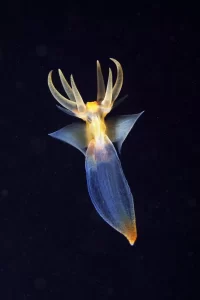The rhythmic flapping of its wings propels the sea angel through the open ocean, and gives it the appearance of flying. While the graceful movements of this swimming snail may make it look like an angel, it’s really a prowling predator. Using a structure called buccal cones, the sea angel removes its prey directly from its shell.
All about the sea angel
What are sea angels?
A sea angel is a type of swimming snail. The muscular foot found in land snails has evolved into a pair of winglike structures called parapodia that are used for swimming in open water. Sea angels have a small, transparent, gelatinous body and do not have a shell.
Sea angels vs. sea butterflies
Sea angels and sea butterflies are both pteropods — swimming sea snails and slugs. Sea angels, or Gymnosomata (which means “naked body”), do not have a shell. Sea butterflies (Thecosomata) are usually smaller and have shells.


Diet
Sea angels are predators that devour other swimming snails, including sea butterflies. One species, Clione limacina, is a very selective eater — it feeds exclusively on sea butterflies in the genus Limacina.
When the sea angel comes in contact with a prey item, it pushes out finger-like tentacles from its head that grab onto the prey. The sea angel then uses hook-like appendages to pull the prey out of its shell and into the sea angel’s gut. The whole process can take from two to 45 minutes.
What eats sea angels?
Sea angels are an important food source for several animals including jellies, ctenophores, fishes, baleen whales, and birds. In the dimly lit waters of the deep sea, the sea angel’s transparent body helps it hide from predators.
How do sea angels reproduce?
Clione are hermaphrodites, meaning they have both female and male reproductive parts. During mating, individuals will come together for several hours at a time and fertilize each other. Once fertilized, the sea angel releases its eggs in a free-floating round mass.
Conservation
Ocean acidification and increasing ocean temperatures may leave sea angels with little to eat. They feed on sea butterflies, whose shells are made from calcium carbonate. As the chemistry of the ocean changes, less calcite and aragonite are available to animals to build their shells and can result in smaller populations.
Cool fact
- Sea angels have small wings compared to their relatives the sea butterflies, but they are very strong swimmers. Using a sculling motion, sea angels are able to swim fast and maneuver quickly.
